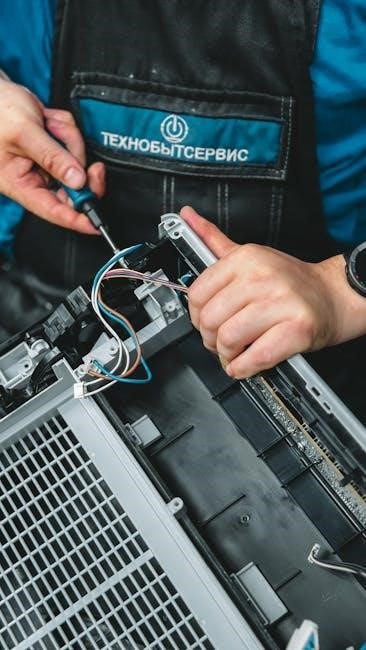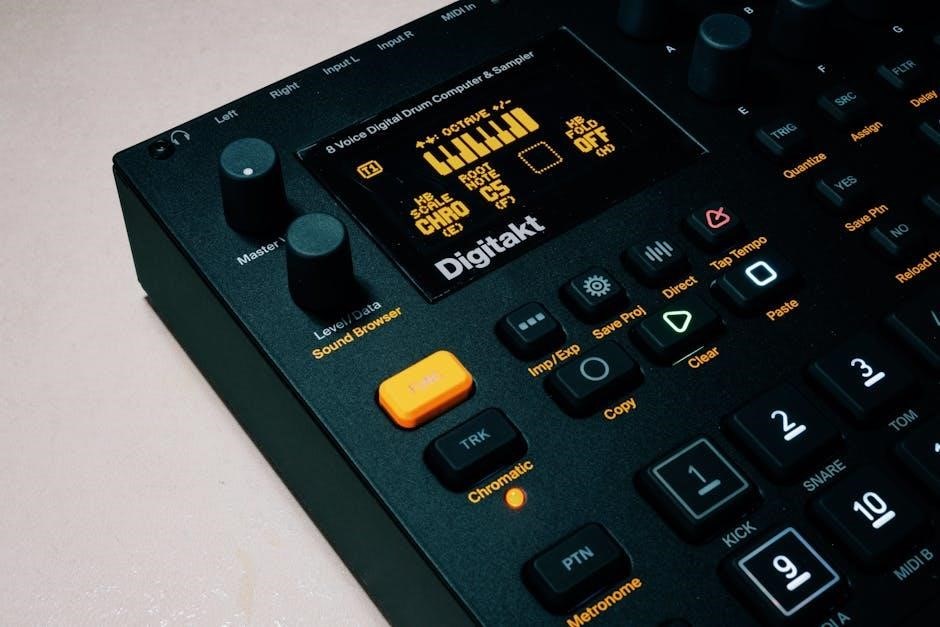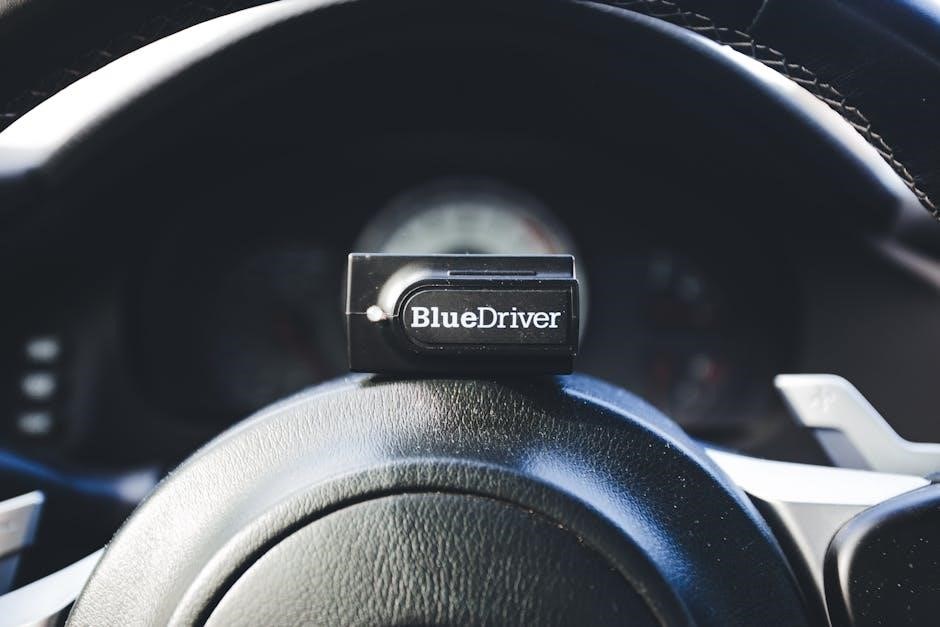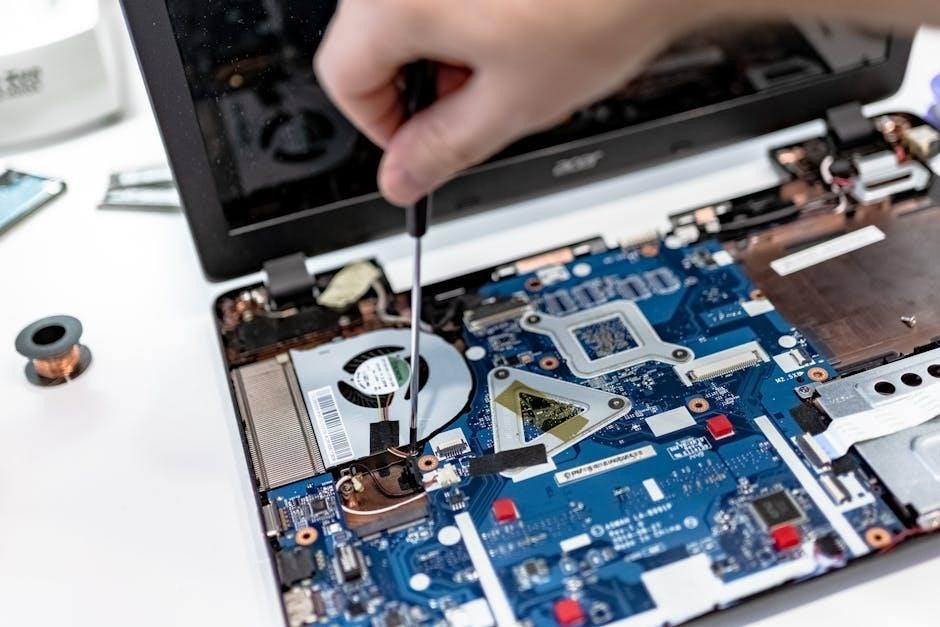The LCI Electronic Leveling System is an advanced electric-hydraulic solution designed to stabilize and level RVs automatically․ It uses a 12V DC motor-driven pump to adjust hydraulic fluid flow‚ ensuring precise leveling․
1․1 What is the LCI Electronic Leveling System?

The LCI Electronic Leveling System is an advanced‚ automated solution designed to stabilize and level recreational vehicles (RVs) with precision․ It integrates electronic controls with hydraulic components to ensure accurate and efficient leveling․ The system operates using a 12V DC electric motor that powers a hydraulic pump‚ which redistributes fluid to adjust the height of the vehicle’s leveling jacks․ This process is monitored by sensors that provide real-time data to the control panel‚ ensuring the vehicle remains level and stable․ The system is known for its ease of use‚ with a user-friendly interface that allows owners to level their RV with minimal effort․ It is commonly used in fifth-wheel trailers and motorhomes‚ offering a reliable alternative to manual leveling methods․ The LCI system is designed to enhance comfort and safety‚ making it a popular choice among RV enthusiasts․ Its electronic and hydraulic components work seamlessly to provide a smooth and efficient leveling experience․

Common Issues and Their Causes
Common issues with LCI Electronic Leveling Systems often stem from low hydraulic fluid levels‚ sensor malfunctions‚ or power connectivity problems․ These issues can disrupt system functionality and require immediate attention to ensure proper operation․
2․1 Hydraulic Fluid Levels and System Pressure
Maintaining proper hydraulic fluid levels is crucial for the LCI Electronic Leveling System’s performance․ Low fluid levels can lead to inadequate pressure‚ causing the system to malfunction or fail to level the RV correctly․ It’s essential to regularly check the fluid reservoir and top it off as needed using the recommended hydraulic fluid type․ Additionally‚ system pressure should be monitored‚ as fluctuations can indicate issues like blockages or worn seals․ If pressure drops unexpectedly‚ inspecting the hydraulic lines for damage or leaks is necessary․ Proper fluid levels and consistent pressure ensure smooth operation and prevent damage to the system’s components․ Always refer to the troubleshooting guide for specific instructions on checking and maintaining hydraulic fluid levels and system pressure to avoid potential breakdowns during use․
2․2 Sensor Malfunctions and Calibration Needs

Sensors play a critical role in the LCI Electronic Leveling System‚ ensuring accurate leveling and stabilization․ Malfunctions often occur due to misalignment‚ dirt‚ or wear and tear․ If sensors detect incorrect data‚ the system may fail to level properly or display error codes․ Calibration is essential to maintain accuracy and should be performed periodically or after any system reset․ To calibrate‚ ensure the RV is on a level surface and follow the manufacturer’s instructions․ If sensors are faulty‚ they may need replacement․ Additionally‚ checking connections and ensuring sensors are clean can resolve many issues․ Proper calibration ensures the system operates efficiently‚ preventing misalignment and instability․ Regular maintenance and sensor checks are vital to avoid unexpected malfunctions during use․ Always consult the troubleshooting guide for specific calibration steps and sensor repair recommendations to keep the system functioning optimally․
2․3 Power Issues and Electrical Connectivity
Power issues and electrical connectivity problems are common causes of malfunction in the LCI Electronic Leveling System․ These problems often arise from blown fuses‚ low battery voltage‚ or faulty wiring․ The system relies on a stable 12V DC power supply to operate the hydraulic pump and sensors․ If the power supply is interrupted‚ the system may fail to initialize or function correctly․ Additionally‚ corroded or loose electrical connections can disrupt communication between components‚ leading to errors or system shutdowns․ To address these issues‚ check the inline fuse near the hydraulic pump and ensure all electrical connections are clean and secure․ If the problem persists‚ verify the battery voltage and inspect the wiring for damage or wear․ Proper electrical connectivity is crucial for the system to operate efficiently and safely․ Regular inspection of power components can help prevent unexpected malfunctions and ensure reliable performance․ Always refer to the troubleshooting guide for detailed diagnostic steps and solutions․

Troubleshooting Steps
Troubleshooting the LCI Electronic Leveling System involves identifying issues systematically․ Start with basic resets and progress to advanced checks like fuse inspections and wiring tests․ Always consult the manual for guidance․ Keywords: reset‚ fuses‚ wiring‚ manual․
3․1 Basic Troubleshooting: Resetting the System
Resetting the LCI Electronic Leveling System is often the first step in resolving issues․ Users can perform a basic reset by pressing all four directional buttons (diamonds) simultaneously for 10-15 seconds; This action recalibrates the system and clears error modes․ If the system indicates an error after resetting‚ check for loose connections or sensor malfunctions․ Another method involves unplugging one of the hall effect sensors‚ attempting auto-leveling to trigger an error mode‚ and then reconnecting the sensor to restart the system․ These procedures are designed to restore functionality without advanced tools․ Always consult the LCI troubleshooting manual for detailed instructions‚ as improper resets may lead to further complications․ Regular resets can also prevent system lockups and ensure optimal performance․ If issues persist‚ proceed to advanced troubleshooting steps like checking fuses and wiring․ Resetting is a simple yet effective solution for many common problems․ Keywords: reset‚ calibration‚ sensors‚ error mode․
3․2 Advanced Troubleshooting: Checking Fuses and Wiring
When basic troubleshooting fails‚ inspecting the electrical components is the next step․ Locate the fuse box associated with the LCI system‚ typically near the hydraulic pump or control panel․ Check for blown fuses‚ which may prevent power from reaching essential components․ Replace any damaged or blown fuses with ones of the correct amperage rating‚ as specified in the manual․ Next‚ examine the wiring harness for signs of damage‚ corrosion‚ or loose connections․ Use a multimeter to test for continuity and ensure no short circuits exist․ Pay particular attention to wiring near moving parts‚ as these areas are prone to wear․ If a wire is damaged‚ repair or replace it promptly to restore system functionality․ After addressing any electrical issues‚ restart the system and test its operation․ If problems persist‚ consult the LCI troubleshooting guide for further diagnostic steps․ Properly maintained wiring and fuses are crucial for reliable system performance․ Keywords: fuses‚ wiring‚ electrical connectivity‚ multimeter․
Maintenance and Preventative Care
Regular maintenance ensures optimal performance of the LCI Electronic Leveling System․ Check hydraulic fluid levels‚ inspect sensors for cleanliness‚ and protect wiring from corrosion․ Addressing issues early prevents costly repairs and system downtime․
4․1 Regular Maintenance for Optimal Performance
Regular maintenance is crucial for the LCI Electronic Leveling System to function smoothly․ Start by checking the hydraulic fluid levels and ensuring they meet the manufacturer’s recommendations․ Low fluid levels can lead to system malfunctions‚ so topping them up as needed is essential․ Next‚ inspect the sensors and electrical connections for any signs of corrosion or damage․ Clean the sensors to ensure accurate readings‚ and tighten any loose connections to prevent power issues․ Additionally‚ lubricate the moving parts of the leveling legs to reduce friction and wear․ Finally‚ test the system periodically by running through a manual leveling cycle to identify any potential problems early․ By following these steps‚ you can extend the lifespan of your system and maintain reliable performance․
4․2 Winterization Tips to Prevent Damage
Winterizing your LCI Electronic Leveling System is essential to prevent damage from freezing temperatures․ Start by protecting the hydraulic components from frost․ Drain the hydraulic fluid and replace it with a non-freezing alternative‚ such as RV-grade antifreeze‚ to avoid ice formation in the lines․ Disconnect the batteries to prevent power drain and corrosion during storage․ Insulate exposed wiring and electrical connections to shield them from cold snaps․ Ensure all hydraulic lines are properly sealed to prevent moisture infiltration․ If storing the system‚ raise the leveling legs slightly to avoid prolonged contact with damp surfaces․ Finally‚ store the system in a dry‚ sheltered area to protect it from harsh weather conditions․ By following these steps‚ you can safeguard your LCI Electronic Leveling System from winter-related damage and ensure it performs optimally when back in use․

Accessing the Troubleshooting PDF Guide
The LCI Electronic Leveling System troubleshooting PDF is available on LCI’s official website or through authorized RV dealers․ Download the manual directly for detailed diagnostic steps and solutions to common issues․

5․1 Where to Find the LCI Troubleshooting Manual

The LCI Electronic Leveling System troubleshooting manual can be found on the official LCI website or through authorized RV dealers․ Visit the support section of the LCI website and search for “troubleshooting guide” or “manual” to download the PDF directly․ Additionally‚ some RV forums and communities share links to the manual for easy access; Ensure you verify the source for authenticity to avoid outdated or incorrect information․ If you cannot find it online‚ contact LCI customer support for assistance․ The manual is typically available in PDF format‚ making it easy to print or save for future reference․ Always refer to the most recent version for accurate troubleshooting steps․
5․2 Navigating the PDF Document for Solutions
The LCI Electronic Leveling System troubleshooting PDF guide is structured to help users quickly identify and resolve issues․ Start by reviewing the table of contents to locate relevant sections based on your specific problem․ The document typically includes categorized troubleshooting steps‚ such as error codes‚ system resets‚ and common symptoms․ Use the search function in your PDF viewer to find keywords like “hydraulic fluid levels” or “sensor calibration” for faster navigation․ Detailed diagrams and step-by-step instructions are provided to guide you through repairs․ Pay attention to sections on resetting the system‚ as this often resolves minor issues․ For advanced problems‚ refer to the wiring and fuse diagrams to identify potential electrical faults․ Always follow the recommended sequence of troubleshooting steps to avoid complicating the issue․ If unsure‚ consult the maintenance tips section for preventative care advice․ Ensure you are using the most recent version of the manual for accurate information․
